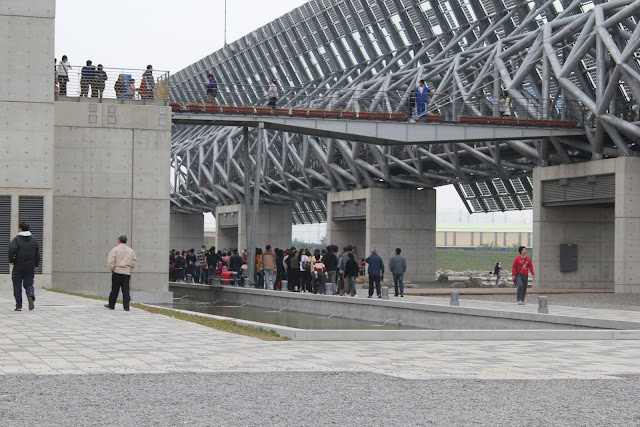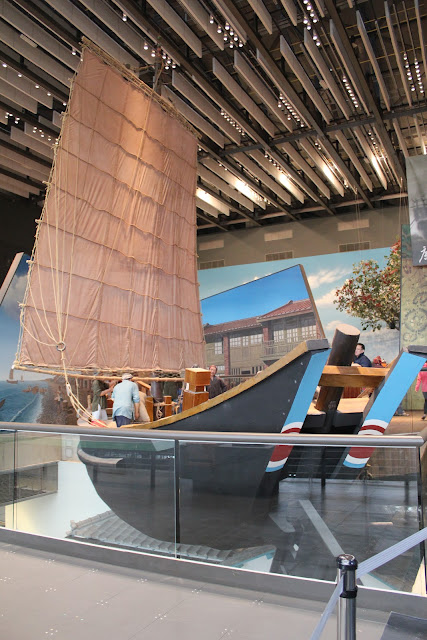National Museum of Taiwan History Opens
Diposkan oleh
Hottest Celebrity
Label:
National Museum of Taiwan History 國立臺灣歷史博物館
The National Museum of Taiwan History in Tainan (國立台灣歷史博物館), the size of a small airport, is finally on board. After years in the works, those who are in charge got the doors open last month. As I've been going past the construction site for years, I decided to not to tarry. Last night, the wife, daughter and self hopped on the high speed train in Taipei and sped down to Tainan. We spent this afternoon going through the various exhibits, spanning from about 7,000 years ago through recent years. I'm not going to go into great depth. I'm simply going to throw up a load of pics with a few comments to separate them. If you want to know more, you're gonna have to head there yourself.
The wait to get in (on a Sunday) is about 30 minutes. Every 15 minutes, they let another 100 people in. As mentioned, the museum is huge; it absorbs the crowds easily. They're also waving the entrance fee for the time being.
This is a replica of one of the boats that brought Chinese people to Taiwan during the early 17th century. Actually, most of the first Chinese settlers came on Dutch ships, but I still found this one interesting.
A replica of a 17th century junk, the kind that delivered a small proportion of the original Chinese settlers to Taiwan during the late Ming Dynasty era.
The placard shows that for most of 18th century, immigration of women to Taiwan was impossible. I appreciated this particular exhibit as it's a theme I've been banging away at for ages on Patrick Cowsill Wanhua Taiwan. The question that naturally should be asked is this: how then was Taiwan's population expanded during this era? If you answered Chinese males normally married aboriginal women, and that is why most Taiwanese people contain aboriginal genes, you deserve a bonus point or two. There is lots of stuff here on the meshing of Chinese and aboriginal culture to create the Taiwan we know today: land ownership issues, tenant-landlord relationships (aborigines actually owned a lot of Taiwan's property) and so on. The development of agriculture in Taiwan is also covered in detail. Taiwan's original prosperity was built on its high productivity in this sector. Some interesting anecdotes on the irrigation wars of the 18th century, when neighbors battled each other to protect their water sources, are finely presented in the museum.
The first 11 non-aboriginal governors of Taiwan were as follows:
Maarten G. SNOCK 1624-5, Gerard Frederiksz RONG DE WITH 1625-7, Pieter NUYTS 1627-9, Hans PUTSMAN 1629-36, Johan VAN DER BURGH 1636-40, Paulus TRAUDENIUSRONG 1640-3, Maximiliaan LEMAIRE 1643-4, Francis CARON 1644-6, Nicolaas G. VERBURGG 1649-53, Cornelius CAESAR 1653-6 and Frederick COYETT 1656-62
None of these individuals are mentioned in the museum (at least so I could see). The language is problematic regarding early colonization. According to the National Museum of Taiwan History, the Japanese "coveted" Taiwan in 1593. Meanwhile, the Dutch "occupied" Taiwan in 1624. But the Chinese "settled down" here during these years, hoping to establish a Han-Chinese "foundation." Notice when the individuals invading Taiwan are non-Chinese, their actions are described in negative terms.
Japanese colonial era (1895-1945)
Main Street, Japanese colonial era
*****
There is also a narrative on the KMT colonial era, including the 2-28 massacre in 1947 and Kaohsiung Incident of 1979, one of the KMT's final attempts to stifle the democratization movement in Taiwan. In the non-permanent section on the third floor, someone has managed to sneak this comment in: "After 1949, the elites and entrepreneurs who retreated from the mainland to Taiwan not only transferred capital and technology to the island, but also further implemented land reforms and developed an economic development strategy. This finally enabled Taiwan to move from being a developing country into being a fully developed, modern society." Nice try. The Taiwan they found was already the second most developed country in Asia -- the China they came from was a backwater by comparison. The initial reaction of the "elites and entrepreneurs" was to cart off what was left of Taiwan's infrastructure after World War II to China and to snuff out any reaction to their presence with 38 years of martial law. Taiwan's economic success was built on the backs of small and medium enterprises, operated primarily by Taiwanese individuals. These companies, and Taiwan's democracy, eventually prospered in spite of the presence of the so-called "elites and entrepreneurs" who "retreated here," or so I've been told.
My wife figures this museum is the better than the National Palace Museum for various reasons. I got a kick out of it too. I'll follow up with tidbits about Wanhua (萬華), where I live, in the coming days and anything else that comes to mind.
Subscribe to:
Post Comments (Atom)










Post a Comment